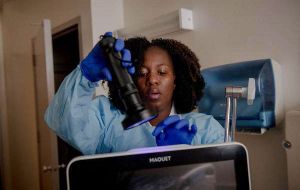MercoPress. South Atlantic News Agency
Mysterious and dangerous fungal infection, Candida Auris has emerged in hospitals and nursing homes
 Candida auris is a fungus that, when it gets into the bloodstream, can cause dangerous infections that can be life-threatening.
Candida auris is a fungus that, when it gets into the bloodstream, can cause dangerous infections that can be life-threatening.  There have been 587 cases reported in the US, according to theCDC, most of them in New York, New Jersey and Illinois.
There have been 587 cases reported in the US, according to theCDC, most of them in New York, New Jersey and Illinois. A mysterious and dangerous fungal infection called Candida auris has emerged around the world. It is resistant to many anti-fungal medications, placing it among a growing number of germs that have evolved defenses against common medicines.
Here are some basic facts about it:
Candida auris is a fungus that, when it gets into the bloodstream, can cause dangerous infections that can be life-threatening. Scientists first identified it in 2009 in a patient in Japan.
In recent years, it has emerged around the world, largely in hospitals and nursing homes. There have been 587 cases reported in the United States, according to the Centers for Disease Control and Prevention, most of them in New York, New Jersey and Illinois.
Candida auris is often resistant to major anti-fungal drugs that are typically used to treat such infections.
CDC says that more than 90 per cent of Candida auris infections are resistant to at least one such drug, while 30 per cent are resistant to two or more major drugs.
Once the germ is present, it is hard to eradicate from a facility. Some hospitals have had to bring in special cleaning equipment and even rip out floor and ceiling tiles to get rid of it.
People with compromised or weakened immune systems are the most vulnerable. This includes elderly people and people who are already sick; in at least one case, newborns were infected at a neonatal unit.
People with weakened immunity are likely to have more trouble fighting off an initial invasion by Candida auris and are also likely to be in settings such as hospitals and nursing homes, where the infection is more prevalent.
The rise of Candida auris has been little publicized in part because it is so new. Outbreaks have also, at times, been played down or kept confidential by hospitals, doctors and even governments.
Some hospitals and medical professionals argue that because precautions are taken to prevent the spread, publicizing an outbreak would scare people unnecessarily.
The symptoms of Candida auris - fever, aches and fatigue - are not unusual, so it is hard to recognize the infection without testing. The good news is that the threat of becoming sick with it is very low for healthy people going about their daily lives.
If you or a loved one is in a hospital or nursing home, you can ask if there have been cases of Candida auris there. If so, it is reasonable to request that proper “infection control” precautions are taken.
In the US, this question would be most relevant in New York, New Jersey and Illinois, specifically Chicago, where the germ has been concentrated.




Top Comments
Disclaimer & comment rulesCommenting for this story is now closed.
If you have a Facebook account, become a fan and comment on our Facebook Page!